Law Society and Controversy: Discrimination Against Women Report
VerifiedAdded on 2023/01/11
|9
|1942
|75
Report
AI Summary
This report examines discrimination against women, focusing on the Equality Act 2010 and related legislation in the UK. It explores various forms of discrimination, including workplace inequality and the impact of the Act on addressing these issues. The report provides an abstract, discusses key legislation, and analyzes a case study, Archibald v Fife Council, to illustrate the application of the law in practice. It covers the aims and changes introduced by the Equality Act, emphasizing its role in promoting equality and addressing gaps in previous legislation. The report also considers indirect discrimination and public sector duties, concluding with a summary of the findings and a list of references.
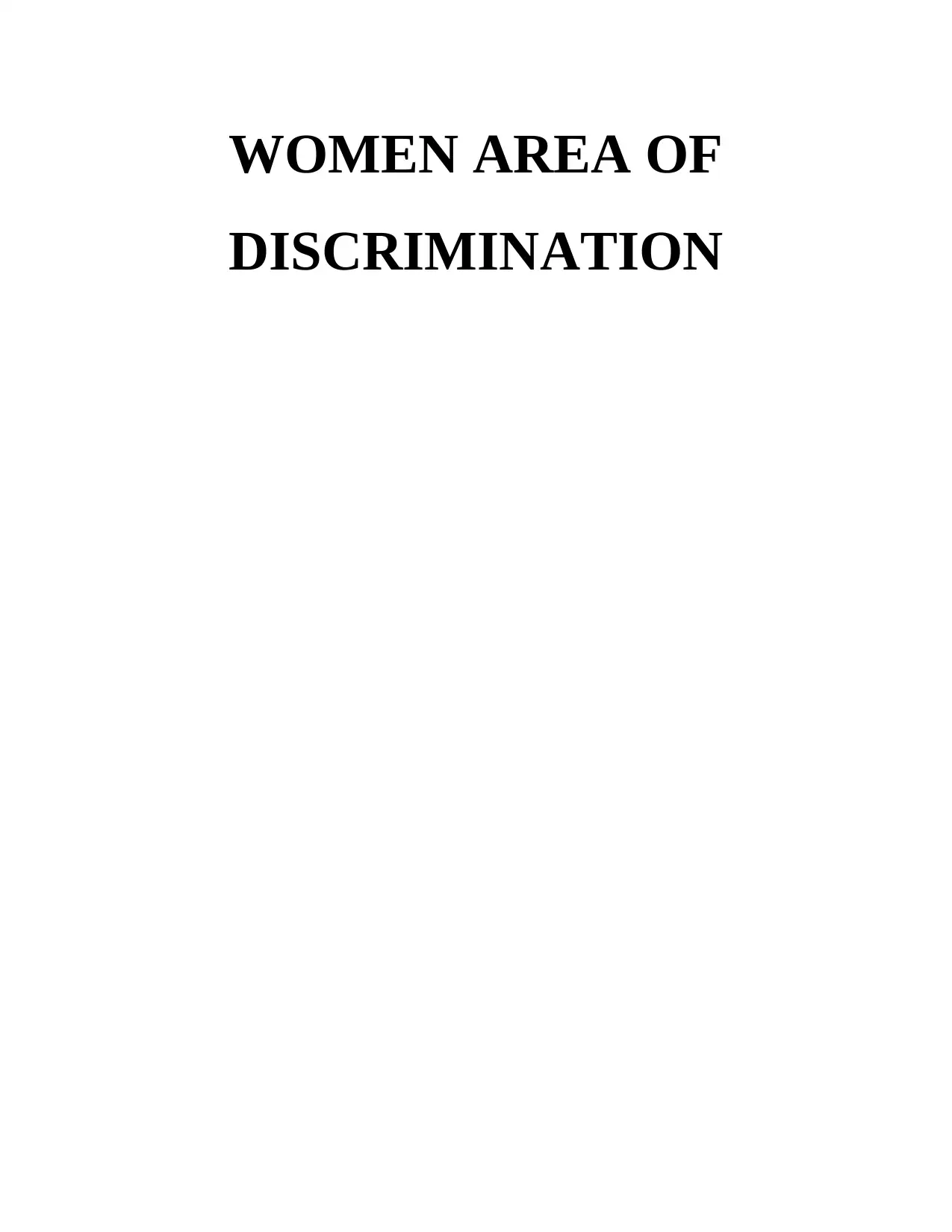
WOMEN AREA OF
DISCRIMINATION
DISCRIMINATION
Paraphrase This Document
Need a fresh take? Get an instant paraphrase of this document with our AI Paraphraser

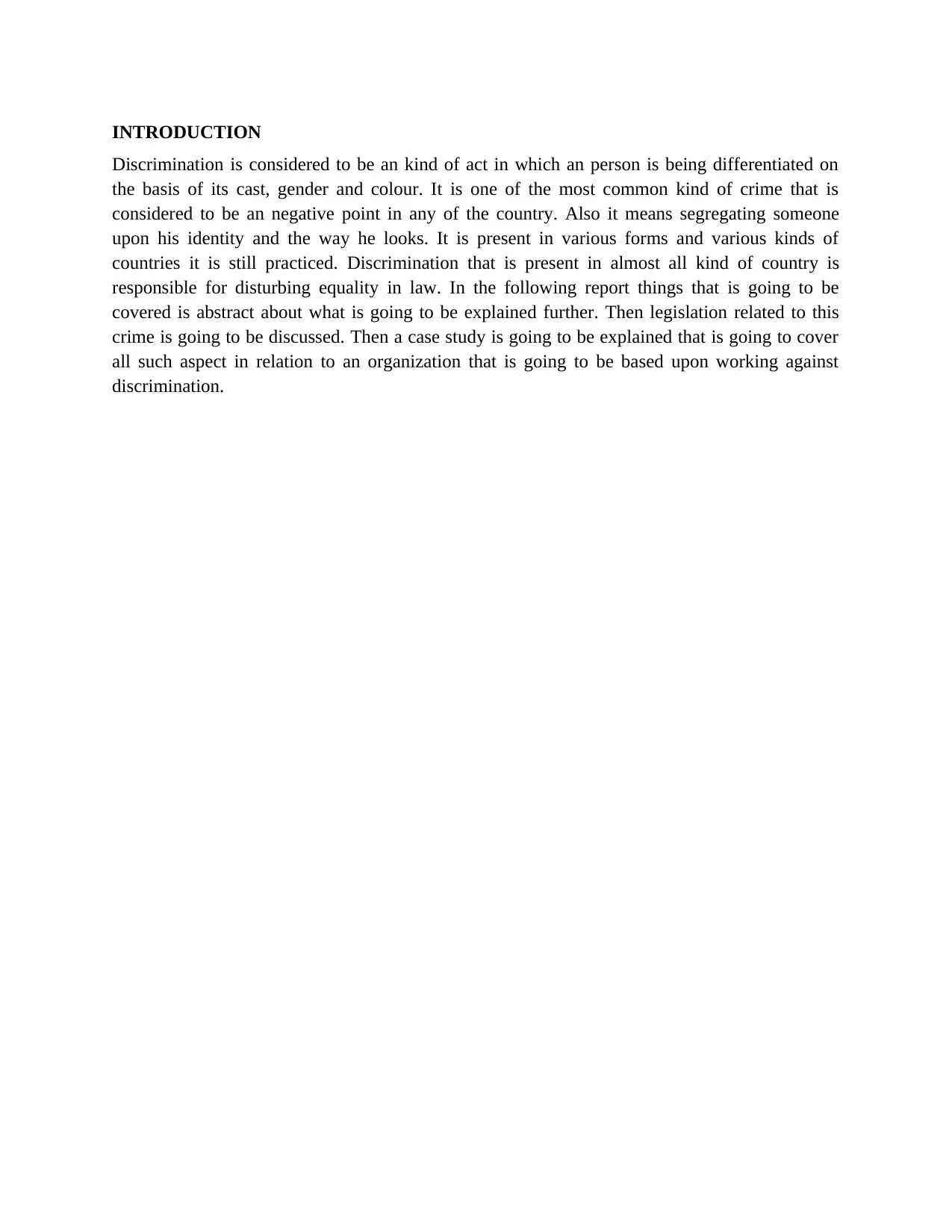
INTRODUCTION
Discrimination is considered to be an kind of act in which an person is being differentiated on
the basis of its cast, gender and colour. It is one of the most common kind of crime that is
considered to be an negative point in any of the country. Also it means segregating someone
upon his identity and the way he looks. It is present in various forms and various kinds of
countries it is still practiced. Discrimination that is present in almost all kind of country is
responsible for disturbing equality in law. In the following report things that is going to be
covered is abstract about what is going to be explained further. Then legislation related to this
crime is going to be discussed. Then a case study is going to be explained that is going to cover
all such aspect in relation to an organization that is going to be based upon working against
discrimination.
Discrimination is considered to be an kind of act in which an person is being differentiated on
the basis of its cast, gender and colour. It is one of the most common kind of crime that is
considered to be an negative point in any of the country. Also it means segregating someone
upon his identity and the way he looks. It is present in various forms and various kinds of
countries it is still practiced. Discrimination that is present in almost all kind of country is
responsible for disturbing equality in law. In the following report things that is going to be
covered is abstract about what is going to be explained further. Then legislation related to this
crime is going to be discussed. Then a case study is going to be explained that is going to cover
all such aspect in relation to an organization that is going to be based upon working against
discrimination.
⊘ This is a preview!⊘
Do you want full access?
Subscribe today to unlock all pages.

Trusted by 1+ million students worldwide
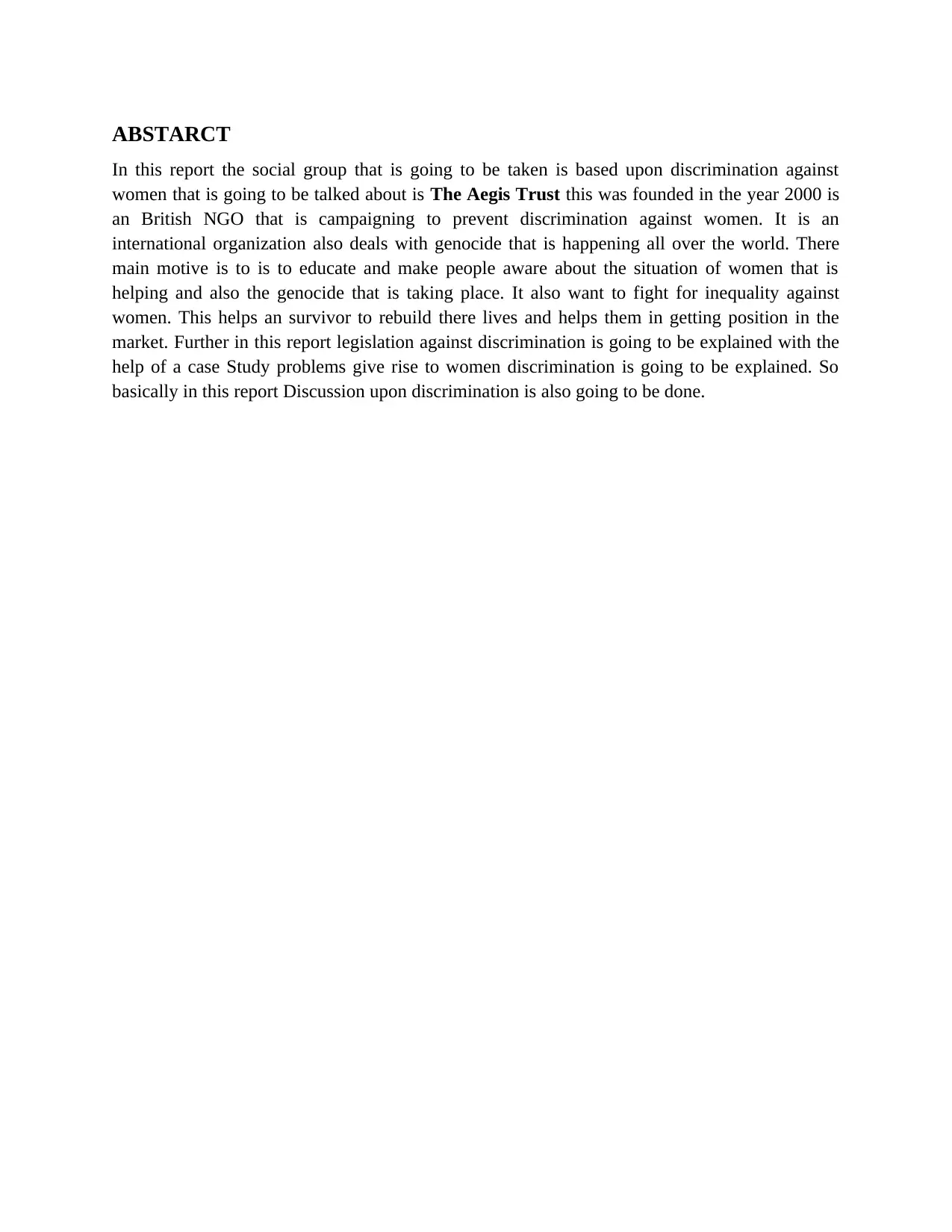
ABSTARCT
In this report the social group that is going to be taken is based upon discrimination against
women that is going to be talked about is The Aegis Trust this was founded in the year 2000 is
an British NGO that is campaigning to prevent discrimination against women. It is an
international organization also deals with genocide that is happening all over the world. There
main motive is to is to educate and make people aware about the situation of women that is
helping and also the genocide that is taking place. It also want to fight for inequality against
women. This helps an survivor to rebuild there lives and helps them in getting position in the
market. Further in this report legislation against discrimination is going to be explained with the
help of a case Study problems give rise to women discrimination is going to be explained. So
basically in this report Discussion upon discrimination is also going to be done.
In this report the social group that is going to be taken is based upon discrimination against
women that is going to be talked about is The Aegis Trust this was founded in the year 2000 is
an British NGO that is campaigning to prevent discrimination against women. It is an
international organization also deals with genocide that is happening all over the world. There
main motive is to is to educate and make people aware about the situation of women that is
helping and also the genocide that is taking place. It also want to fight for inequality against
women. This helps an survivor to rebuild there lives and helps them in getting position in the
market. Further in this report legislation against discrimination is going to be explained with the
help of a case Study problems give rise to women discrimination is going to be explained. So
basically in this report Discussion upon discrimination is also going to be done.
Paraphrase This Document
Need a fresh take? Get an instant paraphrase of this document with our AI Paraphraser
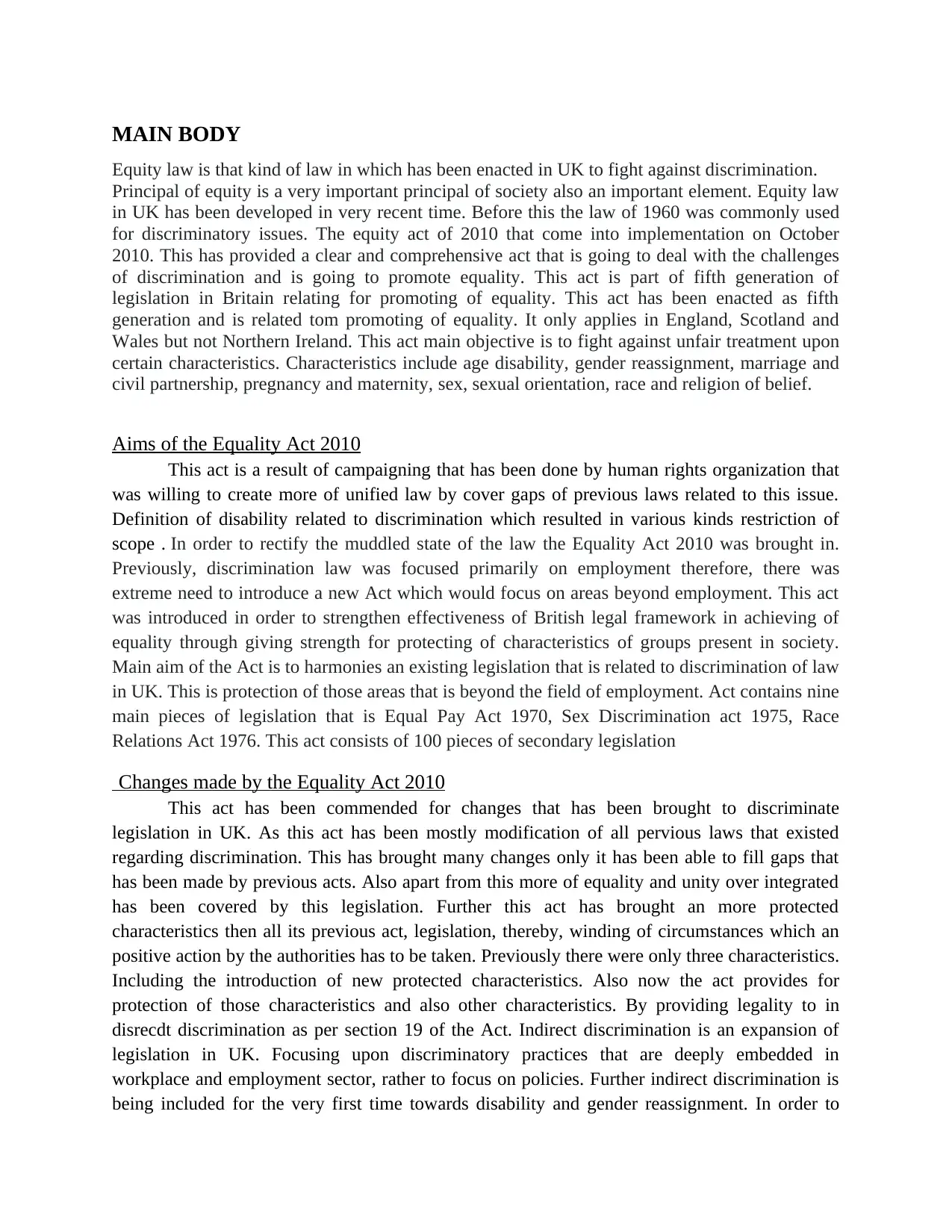
MAIN BODY
Equity law is that kind of law in which has been enacted in UK to fight against discrimination.
Principal of equity is a very important principal of society also an important element. Equity law
in UK has been developed in very recent time. Before this the law of 1960 was commonly used
for discriminatory issues. The equity act of 2010 that come into implementation on October
2010. This has provided a clear and comprehensive act that is going to deal with the challenges
of discrimination and is going to promote equality. This act is part of fifth generation of
legislation in Britain relating for promoting of equality. This act has been enacted as fifth
generation and is related tom promoting of equality. It only applies in England, Scotland and
Wales but not Northern Ireland. This act main objective is to fight against unfair treatment upon
certain characteristics. Characteristics include age disability, gender reassignment, marriage and
civil partnership, pregnancy and maternity, sex, sexual orientation, race and religion of belief.
Aims of the Equality Act 2010
This act is a result of campaigning that has been done by human rights organization that
was willing to create more of unified law by cover gaps of previous laws related to this issue.
Definition of disability related to discrimination which resulted in various kinds restriction of
scope . In order to rectify the muddled state of the law the Equality Act 2010 was brought in.
Previously, discrimination law was focused primarily on employment therefore, there was
extreme need to introduce a new Act which would focus on areas beyond employment. This act
was introduced in order to strengthen effectiveness of British legal framework in achieving of
equality through giving strength for protecting of characteristics of groups present in society.
Main aim of the Act is to harmonies an existing legislation that is related to discrimination of law
in UK. This is protection of those areas that is beyond the field of employment. Act contains nine
main pieces of legislation that is Equal Pay Act 1970, Sex Discrimination act 1975, Race
Relations Act 1976. This act consists of 100 pieces of secondary legislation
Changes made by the Equality Act 2010
This act has been commended for changes that has been brought to discriminate
legislation in UK. As this act has been mostly modification of all pervious laws that existed
regarding discrimination. This has brought many changes only it has been able to fill gaps that
has been made by previous acts. Also apart from this more of equality and unity over integrated
has been covered by this legislation. Further this act has brought an more protected
characteristics then all its previous act, legislation, thereby, winding of circumstances which an
positive action by the authorities has to be taken. Previously there were only three characteristics.
Including the introduction of new protected characteristics. Also now the act provides for
protection of those characteristics and also other characteristics. By providing legality to in
disrecdt discrimination as per section 19 of the Act. Indirect discrimination is an expansion of
legislation in UK. Focusing upon discriminatory practices that are deeply embedded in
workplace and employment sector, rather to focus on policies. Further indirect discrimination is
being included for the very first time towards disability and gender reassignment. In order to
Equity law is that kind of law in which has been enacted in UK to fight against discrimination.
Principal of equity is a very important principal of society also an important element. Equity law
in UK has been developed in very recent time. Before this the law of 1960 was commonly used
for discriminatory issues. The equity act of 2010 that come into implementation on October
2010. This has provided a clear and comprehensive act that is going to deal with the challenges
of discrimination and is going to promote equality. This act is part of fifth generation of
legislation in Britain relating for promoting of equality. This act has been enacted as fifth
generation and is related tom promoting of equality. It only applies in England, Scotland and
Wales but not Northern Ireland. This act main objective is to fight against unfair treatment upon
certain characteristics. Characteristics include age disability, gender reassignment, marriage and
civil partnership, pregnancy and maternity, sex, sexual orientation, race and religion of belief.
Aims of the Equality Act 2010
This act is a result of campaigning that has been done by human rights organization that
was willing to create more of unified law by cover gaps of previous laws related to this issue.
Definition of disability related to discrimination which resulted in various kinds restriction of
scope . In order to rectify the muddled state of the law the Equality Act 2010 was brought in.
Previously, discrimination law was focused primarily on employment therefore, there was
extreme need to introduce a new Act which would focus on areas beyond employment. This act
was introduced in order to strengthen effectiveness of British legal framework in achieving of
equality through giving strength for protecting of characteristics of groups present in society.
Main aim of the Act is to harmonies an existing legislation that is related to discrimination of law
in UK. This is protection of those areas that is beyond the field of employment. Act contains nine
main pieces of legislation that is Equal Pay Act 1970, Sex Discrimination act 1975, Race
Relations Act 1976. This act consists of 100 pieces of secondary legislation
Changes made by the Equality Act 2010
This act has been commended for changes that has been brought to discriminate
legislation in UK. As this act has been mostly modification of all pervious laws that existed
regarding discrimination. This has brought many changes only it has been able to fill gaps that
has been made by previous acts. Also apart from this more of equality and unity over integrated
has been covered by this legislation. Further this act has brought an more protected
characteristics then all its previous act, legislation, thereby, winding of circumstances which an
positive action by the authorities has to be taken. Previously there were only three characteristics.
Including the introduction of new protected characteristics. Also now the act provides for
protection of those characteristics and also other characteristics. By providing legality to in
disrecdt discrimination as per section 19 of the Act. Indirect discrimination is an expansion of
legislation in UK. Focusing upon discriminatory practices that are deeply embedded in
workplace and employment sector, rather to focus on policies. Further indirect discrimination is
being included for the very first time towards disability and gender reassignment. In order to
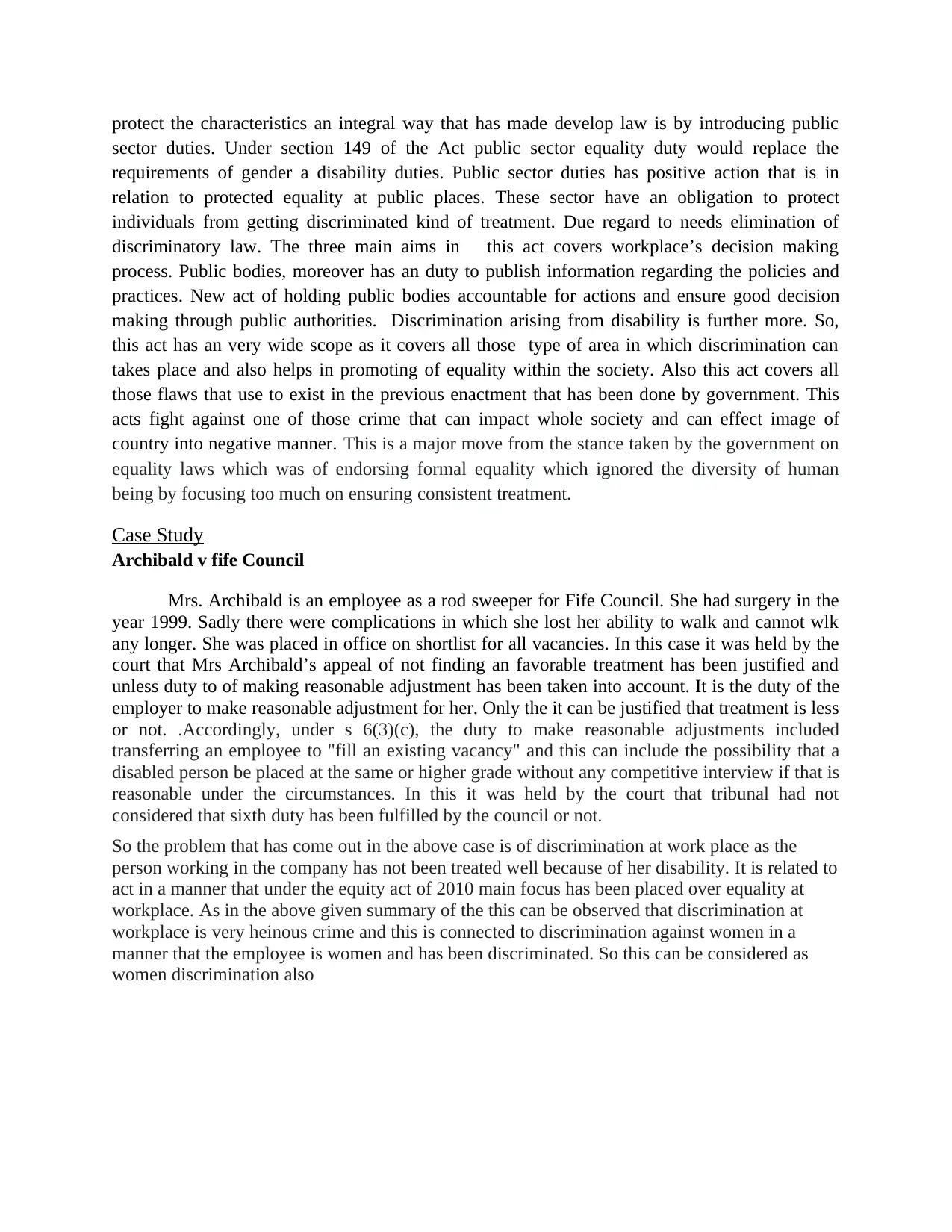
protect the characteristics an integral way that has made develop law is by introducing public
sector duties. Under section 149 of the Act public sector equality duty would replace the
requirements of gender a disability duties. Public sector duties has positive action that is in
relation to protected equality at public places. These sector have an obligation to protect
individuals from getting discriminated kind of treatment. Due regard to needs elimination of
discriminatory law. The three main aims in this act covers workplace’s decision making
process. Public bodies, moreover has an duty to publish information regarding the policies and
practices. New act of holding public bodies accountable for actions and ensure good decision
making through public authorities. Discrimination arising from disability is further more. So,
this act has an very wide scope as it covers all those type of area in which discrimination can
takes place and also helps in promoting of equality within the society. Also this act covers all
those flaws that use to exist in the previous enactment that has been done by government. This
acts fight against one of those crime that can impact whole society and can effect image of
country into negative manner. This is a major move from the stance taken by the government on
equality laws which was of endorsing formal equality which ignored the diversity of human
being by focusing too much on ensuring consistent treatment.
Case Study
Archibald v fife Council
Mrs. Archibald is an employee as a rod sweeper for Fife Council. She had surgery in the
year 1999. Sadly there were complications in which she lost her ability to walk and cannot wlk
any longer. She was placed in office on shortlist for all vacancies. In this case it was held by the
court that Mrs Archibald’s appeal of not finding an favorable treatment has been justified and
unless duty to of making reasonable adjustment has been taken into account. It is the duty of the
employer to make reasonable adjustment for her. Only the it can be justified that treatment is less
or not. .Accordingly, under s 6(3)(c), the duty to make reasonable adjustments included
transferring an employee to "fill an existing vacancy" and this can include the possibility that a
disabled person be placed at the same or higher grade without any competitive interview if that is
reasonable under the circumstances. In this it was held by the court that tribunal had not
considered that sixth duty has been fulfilled by the council or not.
So the problem that has come out in the above case is of discrimination at work place as the
person working in the company has not been treated well because of her disability. It is related to
act in a manner that under the equity act of 2010 main focus has been placed over equality at
workplace. As in the above given summary of the this can be observed that discrimination at
workplace is very heinous crime and this is connected to discrimination against women in a
manner that the employee is women and has been discriminated. So this can be considered as
women discrimination also
sector duties. Under section 149 of the Act public sector equality duty would replace the
requirements of gender a disability duties. Public sector duties has positive action that is in
relation to protected equality at public places. These sector have an obligation to protect
individuals from getting discriminated kind of treatment. Due regard to needs elimination of
discriminatory law. The three main aims in this act covers workplace’s decision making
process. Public bodies, moreover has an duty to publish information regarding the policies and
practices. New act of holding public bodies accountable for actions and ensure good decision
making through public authorities. Discrimination arising from disability is further more. So,
this act has an very wide scope as it covers all those type of area in which discrimination can
takes place and also helps in promoting of equality within the society. Also this act covers all
those flaws that use to exist in the previous enactment that has been done by government. This
acts fight against one of those crime that can impact whole society and can effect image of
country into negative manner. This is a major move from the stance taken by the government on
equality laws which was of endorsing formal equality which ignored the diversity of human
being by focusing too much on ensuring consistent treatment.
Case Study
Archibald v fife Council
Mrs. Archibald is an employee as a rod sweeper for Fife Council. She had surgery in the
year 1999. Sadly there were complications in which she lost her ability to walk and cannot wlk
any longer. She was placed in office on shortlist for all vacancies. In this case it was held by the
court that Mrs Archibald’s appeal of not finding an favorable treatment has been justified and
unless duty to of making reasonable adjustment has been taken into account. It is the duty of the
employer to make reasonable adjustment for her. Only the it can be justified that treatment is less
or not. .Accordingly, under s 6(3)(c), the duty to make reasonable adjustments included
transferring an employee to "fill an existing vacancy" and this can include the possibility that a
disabled person be placed at the same or higher grade without any competitive interview if that is
reasonable under the circumstances. In this it was held by the court that tribunal had not
considered that sixth duty has been fulfilled by the council or not.
So the problem that has come out in the above case is of discrimination at work place as the
person working in the company has not been treated well because of her disability. It is related to
act in a manner that under the equity act of 2010 main focus has been placed over equality at
workplace. As in the above given summary of the this can be observed that discrimination at
workplace is very heinous crime and this is connected to discrimination against women in a
manner that the employee is women and has been discriminated. So this can be considered as
women discrimination also
⊘ This is a preview!⊘
Do you want full access?
Subscribe today to unlock all pages.

Trusted by 1+ million students worldwide

CONCLUSION
From the above file it can be concluded that equity law is one of the most useful
From the above file it can be concluded that equity law is one of the most useful
Paraphrase This Document
Need a fresh take? Get an instant paraphrase of this document with our AI Paraphraser
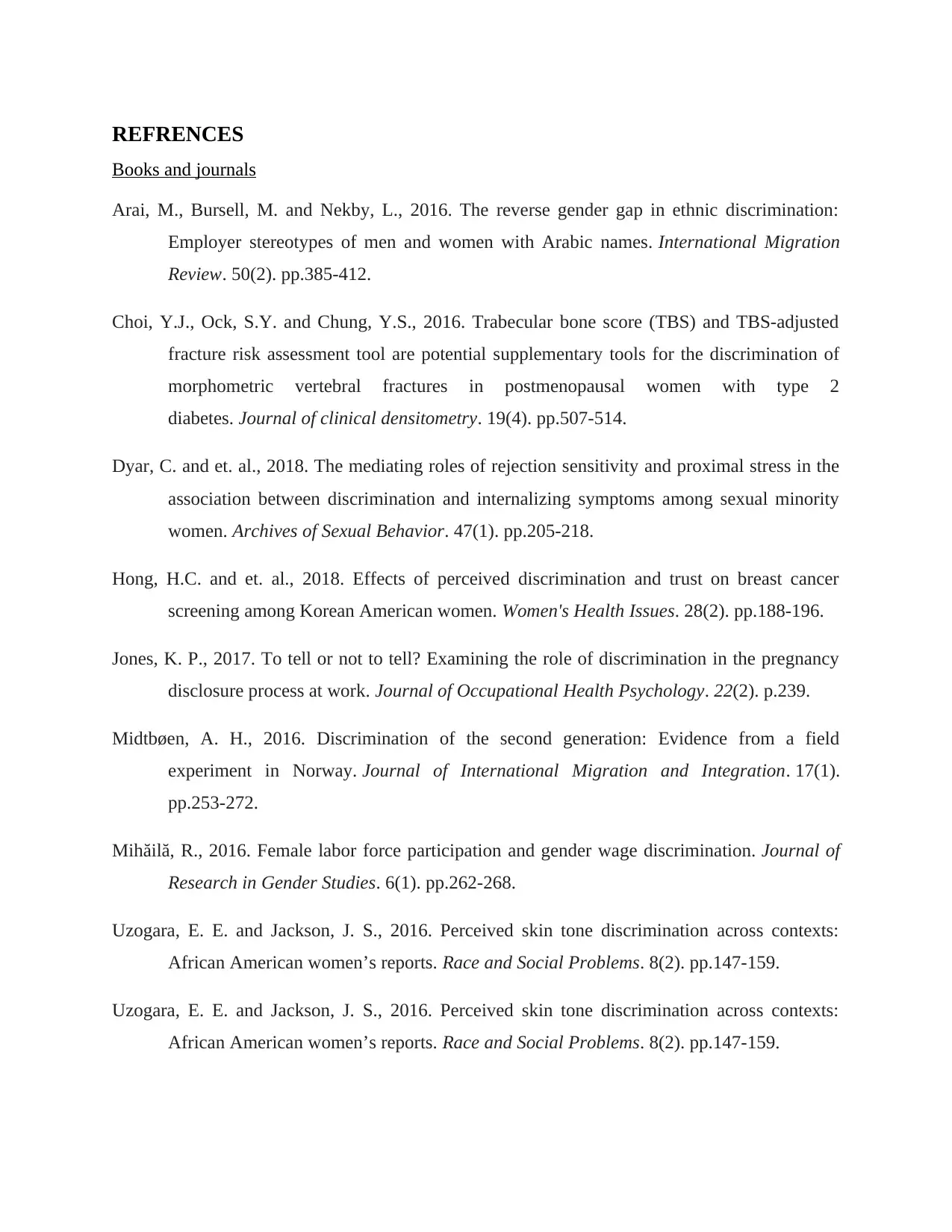
REFRENCES
Books and journals
Arai, M., Bursell, M. and Nekby, L., 2016. The reverse gender gap in ethnic discrimination:
Employer stereotypes of men and women with Arabic names. International Migration
Review. 50(2). pp.385-412.
Choi, Y.J., Ock, S.Y. and Chung, Y.S., 2016. Trabecular bone score (TBS) and TBS-adjusted
fracture risk assessment tool are potential supplementary tools for the discrimination of
morphometric vertebral fractures in postmenopausal women with type 2
diabetes. Journal of clinical densitometry. 19(4). pp.507-514.
Dyar, C. and et. al., 2018. The mediating roles of rejection sensitivity and proximal stress in the
association between discrimination and internalizing symptoms among sexual minority
women. Archives of Sexual Behavior. 47(1). pp.205-218.
Hong, H.C. and et. al., 2018. Effects of perceived discrimination and trust on breast cancer
screening among Korean American women. Women's Health Issues. 28(2). pp.188-196.
Jones, K. P., 2017. To tell or not to tell? Examining the role of discrimination in the pregnancy
disclosure process at work. Journal of Occupational Health Psychology. 22(2). p.239.
Midtbøen, A. H., 2016. Discrimination of the second generation: Evidence from a field
experiment in Norway. Journal of International Migration and Integration. 17(1).
pp.253-272.
Mihăilă, R., 2016. Female labor force participation and gender wage discrimination. Journal of
Research in Gender Studies. 6(1). pp.262-268.
Uzogara, E. E. and Jackson, J. S., 2016. Perceived skin tone discrimination across contexts:
African American women’s reports. Race and Social Problems. 8(2). pp.147-159.
Uzogara, E. E. and Jackson, J. S., 2016. Perceived skin tone discrimination across contexts:
African American women’s reports. Race and Social Problems. 8(2). pp.147-159.
Books and journals
Arai, M., Bursell, M. and Nekby, L., 2016. The reverse gender gap in ethnic discrimination:
Employer stereotypes of men and women with Arabic names. International Migration
Review. 50(2). pp.385-412.
Choi, Y.J., Ock, S.Y. and Chung, Y.S., 2016. Trabecular bone score (TBS) and TBS-adjusted
fracture risk assessment tool are potential supplementary tools for the discrimination of
morphometric vertebral fractures in postmenopausal women with type 2
diabetes. Journal of clinical densitometry. 19(4). pp.507-514.
Dyar, C. and et. al., 2018. The mediating roles of rejection sensitivity and proximal stress in the
association between discrimination and internalizing symptoms among sexual minority
women. Archives of Sexual Behavior. 47(1). pp.205-218.
Hong, H.C. and et. al., 2018. Effects of perceived discrimination and trust on breast cancer
screening among Korean American women. Women's Health Issues. 28(2). pp.188-196.
Jones, K. P., 2017. To tell or not to tell? Examining the role of discrimination in the pregnancy
disclosure process at work. Journal of Occupational Health Psychology. 22(2). p.239.
Midtbøen, A. H., 2016. Discrimination of the second generation: Evidence from a field
experiment in Norway. Journal of International Migration and Integration. 17(1).
pp.253-272.
Mihăilă, R., 2016. Female labor force participation and gender wage discrimination. Journal of
Research in Gender Studies. 6(1). pp.262-268.
Uzogara, E. E. and Jackson, J. S., 2016. Perceived skin tone discrimination across contexts:
African American women’s reports. Race and Social Problems. 8(2). pp.147-159.
Uzogara, E. E. and Jackson, J. S., 2016. Perceived skin tone discrimination across contexts:
African American women’s reports. Race and Social Problems. 8(2). pp.147-159.

(Choi, Ock and Chung, 2016)(Dyar and et. al., 2018)(Hong and et. al., 2018)(Jones, 2017)
(Midtbøen, 2016)(Mihăilă 2016)(Uzogara and Jackson 2016)(Uzogara and Jackson, 2016)
(Midtbøen, 2016)(Mihăilă 2016)(Uzogara and Jackson 2016)(Uzogara and Jackson, 2016)
⊘ This is a preview!⊘
Do you want full access?
Subscribe today to unlock all pages.

Trusted by 1+ million students worldwide
1 out of 9
Related Documents
Your All-in-One AI-Powered Toolkit for Academic Success.
+13062052269
info@desklib.com
Available 24*7 on WhatsApp / Email
![[object Object]](/_next/static/media/star-bottom.7253800d.svg)
Unlock your academic potential
Copyright © 2020–2025 A2Z Services. All Rights Reserved. Developed and managed by ZUCOL.





